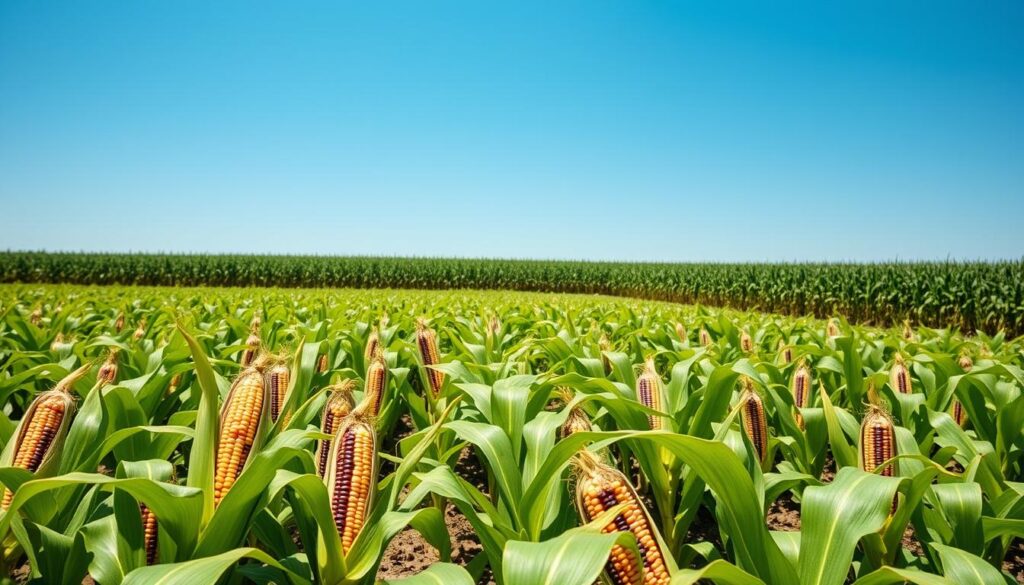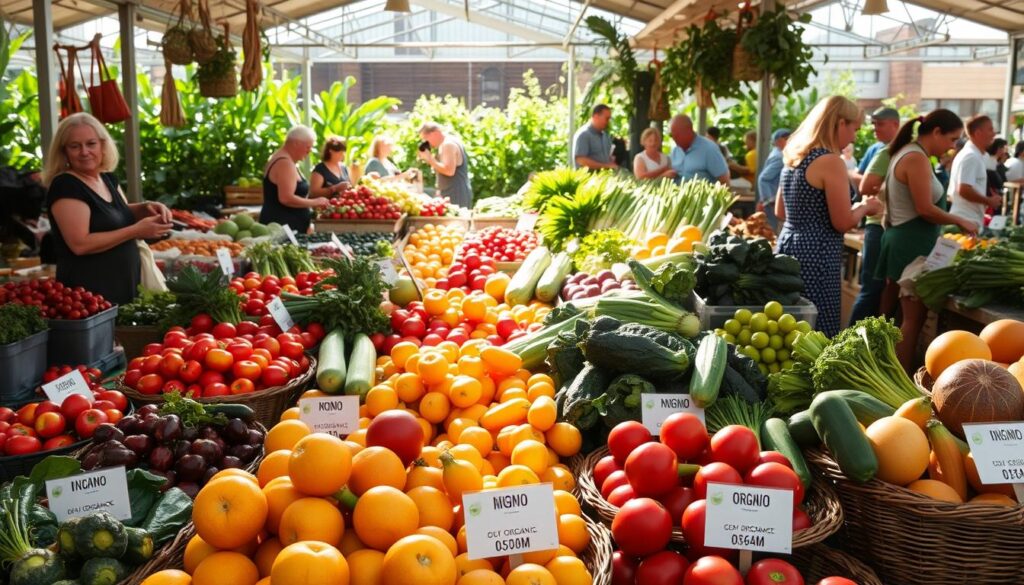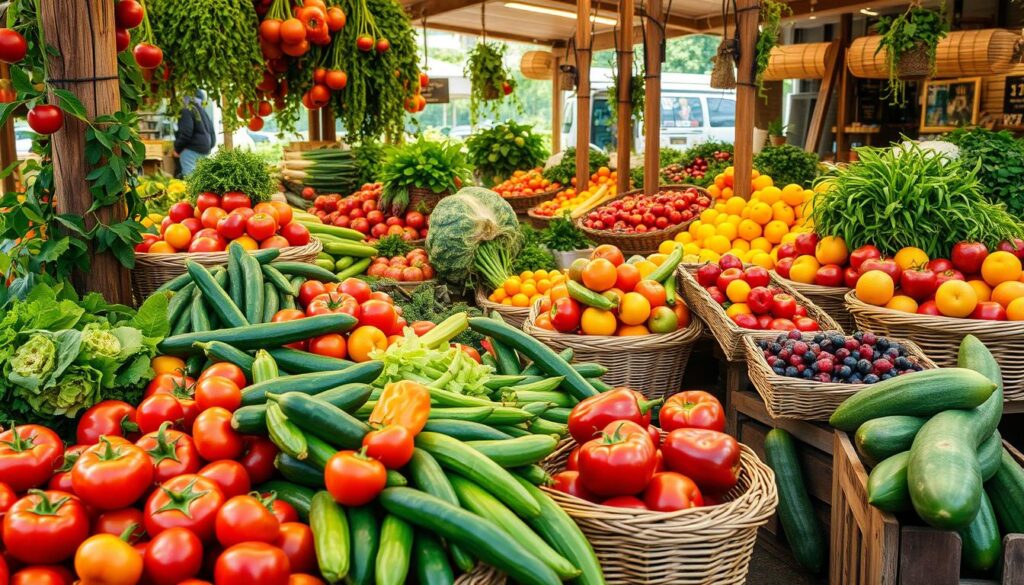Our food choices greatly affect our health and the planet. It’s time to learn about the benefits of non-GMO products. We’ll look into the science of genetic modification, GMO crops’ history, and their use today. You’ll gain the knowledge to make better food choices.
What if the foods we eat could harm us without us knowing? We’ll dive into GMOs and why choosing non-GMO is key for our health and the planet. You’ll discover how to choose a more natural, sustainable food path.
Key Takeaways
- Discover the science behind GMOs and their impact on food production.
- Explore the benefits of choosing non-GMO products in your diet.
- Learn how to identify and avoid GMO ingredients through effective food labeling.
- Discover natural alternatives to GMO products and support sustainable agriculture.
- Understand the connection between organic farming and non-GMO foods.
Understanding GMOs and Their Impact on Food Production
Genetic modification, or genetic engineering, changes the genetic makeup of living things, like food crops. Scientists can add traits like more yield, pest resistance, or better nutrition. But, this technology also raises questions about its effects on the environment and health.
The Science Behind Genetic Modification
Genetic engineering involves finding and adding specific genes to another organism’s DNA. This can be done with plants, animals, or microorganisms. The aim is to create new life forms with special traits. For farming, it’s used to make crops more resistant to pests, diseases, and harsh weather.
Historical Development of GMO Crops
The first GMO crop, a tomato, was approved in the U.S. in 1994. Since then, GMO use in farming has grown. Now, crops like corn, soybeans, and canola are mostly GMO. This has raised concerns about its environmental impact.
Current GMO Statistics in Agriculture
- In 2019, about 190.4 million hectares of land worldwide were used for GMO crops.
- The U.S. leads in GMO crop production, with 71.5 million hectares in 2019.
- Brazil, Argentina, Canada, and India are also big GMO producers.
- The most modified crops are soybeans, corn, cotton, and canola.
As GMO use in farming grows, understanding its science and effects is key. It’s important for sustainable agriculture and the environment.

Benefits of Choosing No GMOs in Your Diet
More people are choosing non-GMO foods as GMO awareness grows. This choice is good for health and the environment. It’s a step towards a better lifestyle.
Non-GMO diets may be healthier. Some research links GMOs to health problems like allergies and chronic diseases. By avoiding GMOs, you might avoid these risks and eat better.
Choosing non-GMO also supports organic farming. Organic farming avoids harmful chemicals. This choice helps the planet and our health.
Non-GMO foods are often more natural. They are less processed and closer to their natural state. This means better taste and nutrition.
Choosing non-GMO food is not just about personal health – it’s about supporting a food system that is better for the planet and future generations.” – Jane Doe, Organic Farming Expert
More people want to know where their food comes from. Non-GMO choices are becoming more appealing. They help create a healthier, more sustainable food system.

| Potential Health Benefits of Non-GMO | Environmental Advantages of Non-GMO |
|---|---|
|
|
How to Identify and Avoid GMO Products
Understanding food labels can seem hard, but don’t worry! We’ll show you how to spot and steer clear of genetically modified (GMO) foods. You’ll learn to read labels well and use the Food Scan Genius app. This way, you can choose what you eat wisely.
Reading Food Labels Effectively
To avoid GMO foods, start by getting good at reading labels. Look for the non-GMO or organic seals. These mean the product doesn’t have genetically modified stuff. Also, watch out for GMO ingredients like corn, soy, canola, and sugar beets.
Common GMO Ingredients to Watch For
- Corn and corn-derived ingredients
- Soy and soy-derived ingredients
- Canola oil
- Sugar beets
- Cottonseed oil
- Papaya
- Zucchini and yellow squash
Using the Food Scan Genius App for GMO Detection
For more confidence, try the Food Scan Genius app. It lets you scan barcodes and tells you if a product has GMOs. This app makes choosing non-GMO foods easy.
The Food Scan Genius app has been a game-changer for my family. It takes the guesswork out of grocery shopping and ensures we’re avoiding GMO products with ease.
Get to know food labels, know the GMO ingredients, and use the Food Scan Genius app. You’ll be on your way to a non-GMO life. Enjoy making smart choices and feeling sure about your food.
Natural Alternatives to GMO Products
Looking for a healthier lifestyle? Explore natural, non-GMO alternatives to common foods. You can change your pantry, enjoy tasty snacks, or try new drinks. Nature’s power is in every delicious option.
Choosing non-GMO doesn’t mean giving up taste or convenience. There’s a wide range of non-non-GMO products. From organic farming to sustainable agriculture, they help nourish you and the planet.
Pantry Staples: Rethinking the Essentials
Replace processed and GMO foods with wholesome, non-GMO pantry staples. Try different non-GMO flours, grains, and legumes for tasty meals. Choose brands that focus on sustainable agriculture and organic farming for your daily needs.
Snacks and Treats: Satisfying Cravings Naturally
Enjoy non-GMO products without losing flavor. Find crunchy chips, savory dips, sweet treats, and baked goods without GMOs. Look for brands that use high-quality, non-GMO ingredients for guilt-free indulgence.
Beverages: Quenching Thirst the Natural Way
Stay hydrated with non-GMO drinks. Avoid sugary, artificial drinks and choose refreshing non-GMO juices, teas, and non-dairy milks. These options not only quench your thirst but also offer nutrients and health benefits without GMOs.
| Product Category | Non-GMO Alternatives | Key Benefits |
|---|---|---|
| Pantry Staples | Non-GMO flours, grains, legumes | Whole, unmodified ingredients; support for sustainable agriculture and organic farming |
| Snacks and Treats | Non-GMO chips, dips, baked goods | Satisfy cravings with natural, non-GMO products |
| Beverages | Non-GMO juices, teas, non-dairy milks | Hydrate naturally without genetically modified components |
By choosing these natural, non-GMO products, you enjoy your favorite flavors while supporting a better future. Explore non-GMO alternatives for a healthier, more sustainable lifestyle.
The Connection Between Organic Farming and Non-GMO Foods
Organic farming and non-GMO food production are closely linked. They both aim to offer healthy, eco-friendly food options. This is key for sustainable agriculture.
Certification Standards and Requirements
Farmers must follow strict rules to get organic certification. The USDA sets these standards. They include no synthetic pesticides, fertilizers, or GMOs.
Non-GMO foods also have strict rules. They need thorough testing to prove they don’t contain GMOs.
Supporting Sustainable Agriculture Practices
- Organic farming uses natural methods to improve soil health.
- Non-GMO farming encourages biodiversity and avoids monocultures.
- Both methods help reduce the environmental impact of food production.
| Organic Farming | Non-GMO Agriculture |
|---|---|
| Avoids synthetic pesticides and fertilizers | Excludes genetically modified organisms |
| Emphasizes soil health and biodiversity | Promotes natural, traditional breeding methods |
| Certified by the USDA Organic program | Certified by Non-GMO Project or similar standards |
Supporting organic and non-GMO farming helps our food system. It focuses on the environment and our health. This approach is crucial for a future where organic farming and sustainable agriculture grow with non-GMO food labeling.
Health Considerations and Environmental Impact
Exploring non-GMO food choices leads us to think about health and the environment. We worry about GMOs’ long-term effects on our bodies and the damage industrial farming does to nature. These issues are key to making smart food choices.
Health worries about GMOs are big. Some research says they’re safe, but others raise concerns about digestion, immunity, and disease risk. The debate on GMO safety is ongoing.
The environmental harm from GMO crops is also a big deal. GMOs often need lots of pesticides and herbicides, harming soil, water, and wildlife. This hurts our planet and ecosystems, making it a major ethical issue.
Considering these health and environmental issues helps us choose better food. Opting for non-GMO foods is more than a personal choice. It’s about supporting a sustainable food system that’s good for us and the planet.
| Health Concerns | Environmental Impact |
|---|---|
|
|
Understanding GMOs’ health and Environmental Impacts helps us make better choices. Choosing non-GMO foods is a step towards a healthier, greener food system. It’s good for us and the planet.
Shopping Tips for Non-GMO Food Choices
Choosing non-GMO foods is easy with the right tips. You can add more no-GMO products to your diet. This supports sustainable farming and is good for your health. Let’s find out where to buy non-GMO foods and how to shop on a budget.
Best Places to Find Non-GMO Products
Start by visiting local farmers’ markets and CSAs. These places focus on small, natural farms. You can also check health food stores and online platforms that sell non-GMO products.
Budget-Friendly Non-GMO Shopping Strategies
- Meal plan and make a shopping list to avoid impulse purchases and stay on budget.
- Buy in bulk for commonly used non-GMO pantry staples, such as grains, legumes, and nuts.
- Opt for store-brand non-GMO options, which are often more affordable than name-brand counterparts.
- Embrace seasonal produce, which tends to be more budget-friendly and nutrient-dense.
- Explore plant-based protein sources, like beans and lentils, as cost-effective non-GMO alternatives to meat.
These tips make shopping for non-GMO foods easy and affordable. Every small step helps create a healthier food system.
The best way to find non-GMO products is to shop local and look for trusted organic and natural food brands.
| Tip | Description |
|---|---|
| Explore Local Sources | Farmers’ markets, CSAs, and specialty health food stores are excellent places to find non-GMO products directly from producers. |
| Check Grocery Store Aisles | Many mainstream grocery stores now have dedicated non-GMO sections or clearly labeled non-GMO options. |
| Shop Online | E-commerce platforms that specialize in natural and organic products offer a wide selection of non-GMO options. |
| Buy in Bulk | Purchasing non-GMO pantry staples, such as grains and legumes, in bulk can be a cost-effective strategy. |
Making the Transition to a Non-GMO Lifestyle
Are you ready to start a non-GMO lifestyle? It’s a journey to a healthier, more natural life. We’re here to help you every step of the way. Switching from GMO products to non-GMO ones might seem hard at first. But with the right tools and strategies, it can be easy and rewarding.
Using the Food Scan Genius app is a great way to begin. This app helps you find products without GMOs. It lets you scan barcodes and explore a vast non-GMO database. You’ll discover many natural, wholesome options.
Start by replacing your staple items with non-GMO ones. Begin with common GMO foods like processed items, grains, and some fruits and veggies. Don’t try to change everything at once. Celebrate each small win as you go.
- Find your favorite non-GMO alternatives for everyday items like bread, pasta, and snacks.
- Look for local farmers markets and specialty stores with lots of non-GMO and organic produce.
- Try new recipes and cooking methods that show off non-GMO ingredients’ natural flavors.
The journey to a non-GMO lifestyle is ongoing. With patience, persistence, and tools like the Food Scan Genius app, you’re on the path to a healthier life. Enjoy the tasty benefits of your non-GMO choices!
Conclusion
As we wrap up our exploration of natural food choices, let’s reflect on what we’ve learned. We’ve looked into the science of genetic modification and GMO crops’ history. We’ve also seen how GMOs are used today in farming.
This knowledge helps us see why choosing non-GMO foods is good for us. It’s about making smart choices for our health and the planet.
We’ve talked about the importance of reading food labels and spotting GMO ingredients. The Food Scan Genius app is a great tool for this. It helps us pick the right foods for a non-GMO diet.
Every choice we make matters. By choosing No GMOs and natural foods, we help ourselves and the environment. Keep looking for non-GMO options and share what you learn with others.
Together, we can make the world a healthier place. One natural food choice at a time.
FAQ
What are GMOs and why do they matter?
GMOs, or genetically modified organisms, are living things changed to have certain traits. Many worry about their health and environmental effects. That’s why choosing non-GMO products is becoming popular.
How can I identify non-GMO products?
To find non-GMO products, read food labels closely. Look for “Non-GMO Project Verified” or “USDA Organic” labels. The Food Scan Genius app can also help you find GMO-free options quickly.
What are the benefits of choosing non-GMO foods?
Choosing non-GMO foods might offer health benefits. They also support sustainable farming and are often chosen for ethical reasons. Some believe genetic engineering is something to think about carefully.
Where can I find non-GMO products?
You can find non-GMO products in many places. Check out local natural food stores, specialty grocery stores, and even big supermarkets. Online stores and farmers’ markets are also good places to find them.
How can I make the transition to a non-GMO lifestyle?
Switching to a non-GMO lifestyle can be easy. Begin by replacing some products with non-GMO ones. Use the Food Scan Genius app to find GMO-free items. Look for natural, organic choices for your home. Over time, choosing non-GMO will become second nature.





